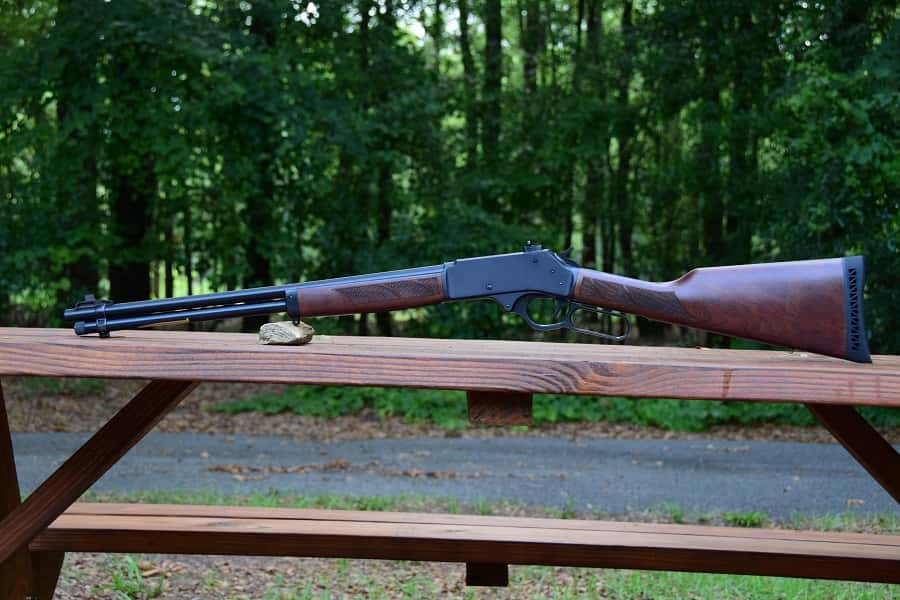Henry .30-30 H009 Rifle
Jim Grant 07.06.15

The most common American hunting lever-gun cartridge is irrefutably the ubiquitous .30-30. Due to its prevalence among farmers and those with no interest in firearms outside hunting, it has been unfairly typecast as a “fudd caliber” for years. This same stigma has led many modern shooters away from learning about it. This is unfortunate, since it’s one of the easiest-shooting medium game-hunting cartridges with a respectable variety of ammo loads available for animals ranging from whitetail to black bear.
Thankfully, American arms-maker Henry Rifles appreciates the round’s capabilities and offers one of its newest rifles in it—the H009 Henry .30-30.
I had trouble coming around to .30-30 at first as well. Given the lack of affordable plinking loads, its restriction to lever guns, and its reputation as a hunting-only caliber, I didn’t see any point in adopting it. This is because my primary interests as a shooter are with historical, tactical, survival, and competition firearms. It wasn’t until Henry introduced one of their lever-action carbines in .30-30 that I began to take another look.

Sporting a no-nonsense matte-black finish and low-gloss satin wood polish, the Henry .30-30 is atypical of their line of ultra-flashy leverguns; it may be an attractive rifle, but the H009 is no wall-hanger. Gone is the heavy, ornate octagon barrel and diminutive, historically correct buckhorn iron sights. In their stead, the Henry sports a 20-inch blued barrel and fast-shooting XS Ghost Ring aperture sights. The latter proved remarkably accurate in testing.
Though the sights are effective, they don’t solve one of the primary issues with the .30-30 round: its lackluster long-range performance compared to popular calibers like .30-06 and .308. This was an element that I struggled with, when considering the carbine, but it wasn’t until I got some trigger time that I fully understood the .30-30’s appeal.
The .30-30 round isn’t as ballistically impressive as the aforementioned calibers, but also doesn’t produce punishing recoil in such a light rifle (it weighs only seven pounds). While both .30-06 and .308 are tolerable in heavy target rifles and semiautomatics, they are brutal to small shooters when paired with featherweight rifles. The .30-30, on the other hand, was pleasant with both 150- and 170-grain hunting loads. It was so fun to shoot that I found myself reloading quickly and burning through $200 of ammunition in an hour, which brings me to my biggest concerns for the rifle: ammo cost and the rifle’s reloading procedure.

These issues bear mentioning to recreational shooters like myself who enjoy blowing through a case of ammo in a single range visit. Reloading the rifle, like all Henry rifles, is more awkward than with a Winchester or Marlin rifle. This is because unlike those two cowboy-arsenal mainstays, the Henry lacks a loading gate on its receiver. Instead, the Henry .30-30 has a loading gate toward the end of its magazine retention tube that houses a brass magazine, which contains a bright orange follower and large spring.
The rifle is charged by opening the action to ensure it’s empty, then twisting the magazine tube knob below the muzzle 45 degrees. This unlocks the magazine from the housing, which is then pulled forward and free from the rifle. The shooter then inserts fresh rounds into the now-hollow tube housing, before replacing the brass magazine tube, and turning it to lock. If this sounds convoluted, that’s because it is. The bright side is that as a non-combat, non-sport-shooting rifle, reload times are basically meaningless to all but those with the most abysmal marksmanship.
Shooters who do understand the perishable skills of riflery will really appreciate the Henry’s capabilities. In testing 170-grain Federal loads, I achieved 1.73-inch groups at 100 yards when fired from a rest, while lighter 150-grain loads did just a hair over 2 MOA at 2.14 inches. Both are more than adequate for hunting, especially given the round’s effective range.

Lastly, there is one aspect of lever guns that is difficult to describe. It’s similar to the French concept of je ne sais que. Racking the lever accomplishes the same thing as working a bolt, but feels better in a way. I compared how the Henry’s action felt, to older, hand-fitted lever action rifles, like my personal Winchester 1892 in .32 WCF. While it’s not as smooth, the Henry definitely inspired confidence with how rock-solid the action feels—especially when compared to the .357 Magnum Big Boy they make, which is nothing to scoff at. When the Henry’s bolt goes into battery, it’s almost like closing the breech on a cannon; like some great over-built machine conquering the very forces of nature. I does sound a bit ridiculous, but it’s its power is undeniable once you feel it.
The verdict?
The Henry is a cool, nostalgic alternative to other modern .30-30 carbines, many of which are suffering from bad quality control issues. If you want a reliable hunting lever action rifle in a ubiquitous, proven caliber that doesn’t beat you up (and you want it 100 percent made in America), you have to buy a Henry. The H009 retails for $850, a very fair price for such a high-quality firearm.

